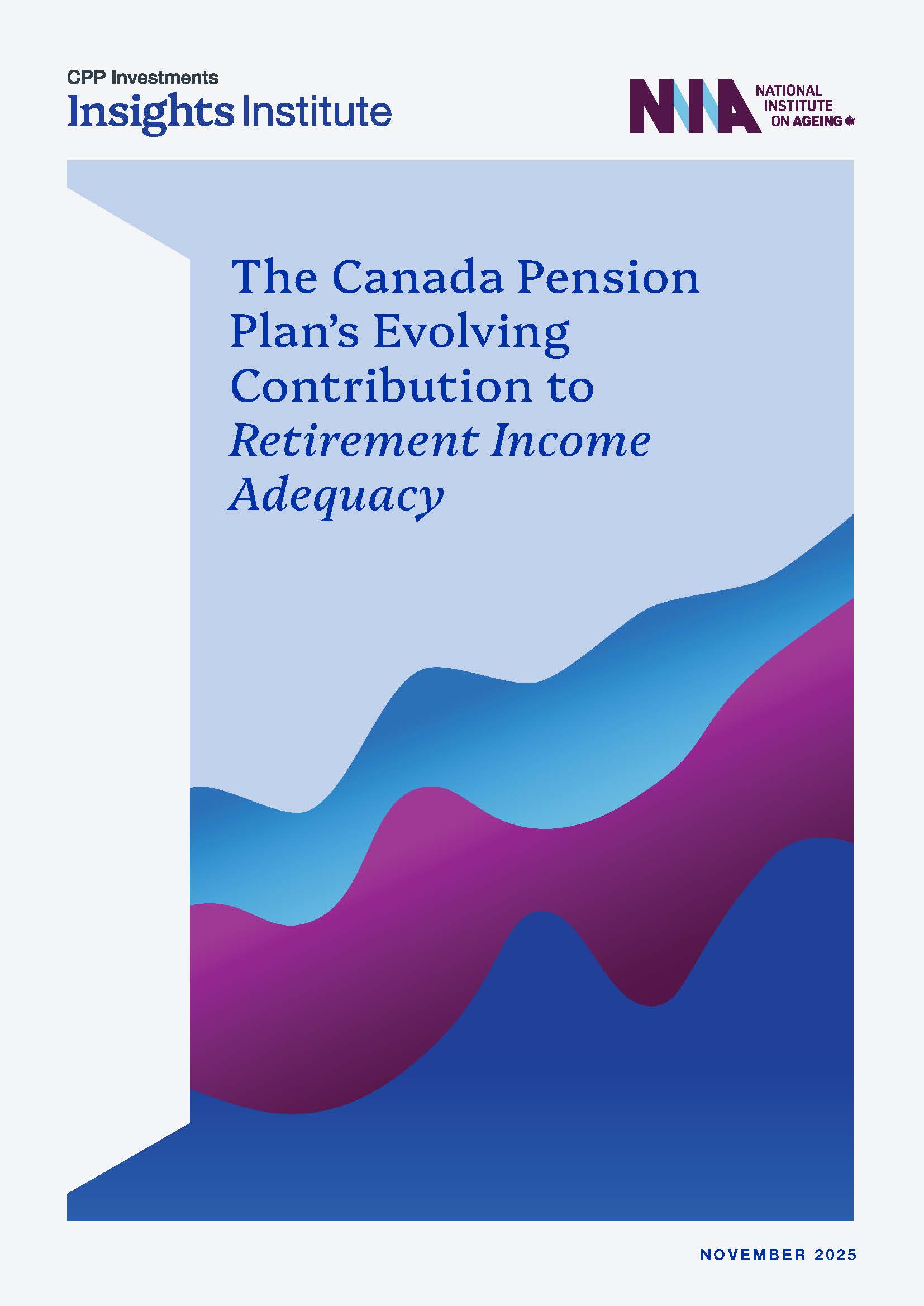What does it mean to be a super-aged society?
For Canada, that question will soon demand an answer. By 2030, Canada will join Japan, Italy, and Germany in transitioning to a super-aged nation, where more than one in five citizens are over age 65. It won’t be alone. This same demographic shift is set to play out across advanced economies, reshaping labour markets, fiscal policies, and social contracts.
More than this, it’s expected to exacerbate the arrival of one of the most pressing economic challenges facing developed nations: the risk of individuals outliving their savings.
Longer lives are a collective achievement. The challenge, and opportunity, is to turn those extra years into a societal advantage through thoughtfully designed social programs, including a well-structured retirement income system. In doing so, advanced economies can unlock a longevity dividend, where population aging becomes not a burden but a new source of economic vitality and social contribution.
Which countries are best placed to move into this new chapter? As the World Bank and World Economic Forum have observed, societies that pair longevity with economic stability, robust pensions, and social cohesion are best positioned to turn aging from a headwind into a source of strength.
A new study from the CPP Investments Insights Institute and the National Institute on Ageing (NIA), The Canada Pension Plan’s Evolving Contribution to Retirement Income Adequacy, examines the CPP’s role in this transition. The study explores the plan’s broader evolution—its benefit design, funding model, and investment governance—and how it has contributed to the long-term well-being of Canadians. It finds that, through its design, which includes mandatory contributions, indexed lifetime benefits, and broad population coverage, the CPP acts as a form of public longevity insurance. That is, it provides a predictable retirement income that helps protect Canadians against outliving their savings and supports continued participation in work, volunteering, and community life.
Indeed, research suggests that the payoff from rising life expectancy lies not simply in longer lives, but in longer, more productive and engaged lives. The National Institute on Ageing has previously how adequate, stable and secure retirement income is associated with better mental and physical health outcomes among older Canadians. It enables older adults to invest in their health, remain socially and economically engaged, and reduce reliance on costly care services. Further, financial security enables people to age in the place of their choice, which supports better health and well-being, while also strengthening social capital. Financially secure seniors are more likely to volunteer, participate in community life, and support their families.
The Insights Institute-NIA study notes that the CPP strengthens retirement income stability across earnings levels, promotes intergenerational fairness, and reinforces confidence in the sustainability of Canada’s retirement system.
“Canada’s CPP model gives us a structural advantage as we enter the era of super-aging,” says Michel Leduc, Senior Managing Director and Chief Public Affairs Officer at CPP Investments. “Because it was built on shared contributions, independent management, and long-term discipline, it helps position Canada to manage the fiscal realities of aging with stability and foresight.”
Canada’s Demographic Transition: The shape of a super-aged society
In 1966, when the CPP was created, Canada had 7.7 working-aged people for every retiree. Today, that ratio has fallen to just over 3 to 1 and will continue to decline as fertility rates remain near record lows (Statistics Canada, 2022). Meantime, the share of Canadians aged 65 and older has risen from 8% in 1971 to 19% today, on track to reach 26% by 2068. This mirrors patterns across the OECD: Japan’s senior share is already 30%, Italy’s is 24%, and South Korea’s will cross the 25% threshold by 2030ii.
This demographic pivot raises important questions for economic stability. Longer lifespans mean longer retirements—often spanning two or three decades—while slower population growth limits the tax base that funds public benefits.
As the population continues to age, the role of the CPP will become more pronounced, particularly for individuals with limited private pension access or insufficient personal savings. Indeed, in Canada, employer pension coverage has stagnated, with only 38% of paid workers enrolled in a registered workplace pension as of 2023 (Statistics Canada, 2024). Moreover, the security offered by those plans is changing. In the private sector, defined benefit plan coverage fell from 21.9% in 1997 to 9.2% in 2017. Although defined contribution plan coverage increased over this period, such plans lack the longevity protection of defined benefit arrangements, leaving retirees vulnerable to market swings and life expectancy uncertainty.
Household balance sheets show both strength and vulnerability: while Canadians hold significant real estate and financial assets, personal saving rates have declined sharply over recent decades, leaving many households more reliant on the CPP’s stable, inflation-protected income. As these private safety nets erode, private annuity take-up remains below 10%. The result is that many Canadians are entering retirement with less financial flexibility and greater reliance on the CPP as a stable, inflation-protected source of income.
As the Insights Institute-NIA study finds, the CPP’s design helps fill that gap. Its mandatory and contributory structure ensures that all workers accumulate pension credits, while its inflation indexing protects real purchasing power. For middle-income Canadians—those earning roughly $50,000 to $70,000 annually—CPP benefits represent 50–70% of total retirement income, a share that will rise as enhancements introduced in 2016 phase in.
In insurance terms, it pools the risk of outliving one’s savings across nearly all working Canadians. This is the foundation of what economists call public longevity insurance, a function that becomes more valuable as populations age and private annuity markets remain thin.
In essence, while Canadians are living longer on average, a greater challenge lies in the variability of those lifespans—indeed, some retirees will live beyond the average. By pooling that uncertainty, the CPP shares risk among contributors within cohorts so that those who live longer receive benefits financed in part by those with shorter lifespans. At current contribution and benefit rates, the CPP’s sustainability reflects the longevity assumptions already incorporated by the Office of the Chief Actuary (OCA). (Note: Life expectancies that rise faster than those projections would require adjustments by the OCA.) According to the Insights Institute–NIA study, a Canadian retiring at age 65 in 2024 can expect to live another 20 years, rising to 27 years by 2100.
“In a world where fewer workers have defined benefit plans, the CPP provides a baseline of lifetime income that can’t be outlived,” says Leduc.
A Structural Advantage: Partial pre-funding and independent management
Unlike pay-as-you-go systems under pressure in Europe and the United States, the CPP operates under a partially pre-funded model, strengthened by the 1997 reforms that created CPP Investments. This structure allows contributions not immediately needed for benefits to be invested globally for long-term growth. The fund’s assets—now over $777 billion—are projected to grow steadily, with investment returns covering the majority of future benefits.
According to the Chief Actuary of Canada (OSFI, 2021), the CPP remains financially sustainable for at least 75 years. That solvency horizon provides rare stability: by comparison, U.S. Social Security faces projected depletion by 2033, while many European public pensions will require higher taxes or lower benefits to stay solvent.
The strength of the CPP’s governance model also matters, the study concludes. CPP Investments operates at arm’s length from government, guided by professional management and a mandate to maximize returns without undue risk of loss. This separation of politics from pensions—unusual among public systems—has bolstered confidence and shielded assets from short-term policy pressures.
Equity and Gaps: Who benefits, and how
The CPP’s universal structure also supports intergenerational equity by pre-funding future benefits rather than relying solely on payroll contributions from younger workers. This approach helps prevent the generational strain seen in some European systems, where shrinking workforces must support expanding retiree populations. By investing contributions today to finance tomorrow’s benefits, the CPP spreads demographic and economic risks more evenly across generations.
However, the Insights Institute–NIA report notes that intergenerational fairness is more complex than a simple transfer between young and old. What may appear as a cross-sectional imbalance often balances out over individuals’ lifetimes, as today’s contributors become tomorrow’s beneficiaries. The CPP’s partially funded design ensures that each generation helps pay for its own retirement while benefiting from the accumulated investment returns of earlier cohorts.
At the same time, broader intergenerational gaps in wealth and opportunity persist. Younger Canadians are contending with slower real wage growth, higher housing costs, and weaker private savings compared to earlier generations. These pressures heighten the importance of public systems like the CPP, which provide predictable, inflation-protected income regardless of market volatility or employment patterns.
In that sense, the CPP not only addresses longevity risk, it also serves as a stabilizing institution amid widening intergenerational inequality. As private wealth accumulates unevenly across age groups, the CPP’s collective, contributory model redistributes some of the economic gains of an aging society back to younger workers in the form of a sustainable and trusted system. This is the foundation of Canada’s potential longevity dividend: a system that turns aging from a fiscal challenge into a shared source of stability and long-term confidence.
Comparative Perspective: A global view
Other high-income countries are wrestling with similar demographic pressures. The OECD’s 2024 Pensions Outlook warns that without reform, pension expenditures could rise significantly by mid-century across advanced economies. Japan’s pension system, one of the oldest and most mature, faces funding shortfalls and low replacement rates. Germany and France have resorted to politically divisive increases in retirement ages. Meanwhile, in the United States, restoring long-term balance to Social Security could require a 25% benefit cut or a 4.15 percentage point payroll tax hike in 2034i.
In this comparative landscape, the CPP’s stability provides Canada with a structural advantage. It’s not that Canada is exempt from demographic stress, it’s that the combination of mandatory participation, diversified global investment, and actuarial discipline creates a cushion many peers lack.
“Canada isn’t younger than its peers,” Leduc observes. “We just acted earlier. By acting early, Canada built a foundation of resilience that will be critical in the decades ahead.”
Key Takeaways
- Sustainability. The CPP’s partially pre-funded model—introduced in 1997—has stabilized contribution rates and protected the plan from the demographic pressures now straining many global pension systems.
- Intergenerational fairness. The study finds that the CPP’s funding model allows each generation to contribute toward its own retirement while benefiting from accumulated investment returns, helping to preserve balance between younger and older Canadians.
- Middle-income Canadians. For workers earning roughly $50,000–$70,000 annually, the CPP represents 50–70% of total retirement income—an increasingly critical share as private pension coverage declines.
- Gender and equity gaps persist, but are narrowing. Women and lower earners tend to receive smaller annual benefits due to career interruptions and wage gaps, but longer lifespans mean they receive higher lifetime value relative to contributions.
- Public confidence. CPP Investments operates at arm’s length from government. Its investment mandate, to maximize returns without undue risk of loss, reduces political risk and reinforces public confidence.
- Canada’s approach offers a structural advantage. The combination of mandatory participation, global investment diversification, and professional governance gives Canada an edge as aging accelerates in advanced economies.
As investors grapple with AI's rapid expansion, responsible development and deployment is becoming an increasingly important investment
Article
June 21, 2024
As Chief Operating Officer at CPP Investments, Jon Webster is on the front lines of the technological change reshaping global investing.
Article
May 16, 2024
Generative artificial intelligence (genAI) is transforming the world of investing.
Article
March 14, 2024
What does it mean to be a super-aged society? For Canada, that question will soon demand an answer. By 2030, Canada will join Japan, Italy, and Germany in transitioning to a super-aged nation, where more than one in five citizens are over age 65. It won’t be alone. This same demographic shift is set to play out across advanced economies, reshaping labour markets, fiscal policies, and social contracts. More than this, it’s expected to exacerbate the arrival of one of the most pressing economic challenges facing developed nations: the risk of individuals outliving their savings. Longer lives are a collective achievement. The challenge, and opportunity, is to turn those extra years into a societal advantage through thoughtfully designed social programs, including a well-structured retirement income system. In doing so, advanced economies can unlock a longevity dividend, where population aging becomes not a burden but a new source of economic vitality and social contribution. Download the Report Which countries are best placed to move into this new chapter? As the World Bank and World Economic Forum have observed, societies that pair longevity with economic stability, robust pensions, and social cohesion are best positioned to turn aging from a headwind into a source of strength. A new study from the CPP Investments Insights Institute and the National Institute on Ageing (NIA), The Canada Pension Plan’s Evolving Contribution to Retirement Income Adequacy, examines the CPP’s role in this transition. The study explores the plan’s broader evolution—its benefit design, funding model, and investment governance—and how it has contributed to the long-term well-being of Canadians. It finds that, through its design, which includes mandatory contributions, indexed lifetime benefits, and broad population coverage, the CPP acts as a form of public longevity insurance. That is, it provides a predictable retirement income that helps protect Canadians against outliving their savings and supports continued participation in work, volunteering, and community life. Indeed, research suggests that the payoff from rising life expectancy lies not simply in longer lives, but in longer, more productive and engaged lives. The National Institute on Ageing has previously discussed how adequate, stable and secure retirement income is associated with better mental and physical health outcomes among older Canadians. It enables older adults to invest in their health, remain socially and economically engaged, and reduce reliance on costly care services. Further, financial security enables people to age in the place of their choice, which supports better health and well-being, while also strengthening social capital. Financially secure seniors are more likely to volunteer, participate in community life, and support their families. The Insights Institute-NIA study notes that the CPP strengthens retirement income stability across earnings levels, promotes intergenerational fairness, and reinforces confidence in the sustainability of Canada’s retirement system. “Canada’s CPP model gives us a structural advantage as we enter the era of super-aging,” says Michel Leduc, Senior Managing Director and Chief Public Affairs Officer at CPP Investments. “Because it was built on shared contributions, independent management, and long-term discipline, it helps position Canada to manage the fiscal realities of aging with stability and foresight.” Canada’s Demographic Transition: The shape of a super-aged society In 1966, when the CPP was created, Canada had 7.7 working-aged people for every retiree. Today, that ratio has fallen to just over 3 to 1 and will continue to decline as fertility rates remain near record lows (Statistics Canada, 2022). Meantime, the share of Canadians aged 65 and older has risen from 8% in 1971 to 19% today, on track to reach 26% by 2068. This mirrors patterns across the OECD: Japan’s senior share is already 30%, Italy’s is 24%, and South Korea’s will cross the 25% threshold by 2030ii. This demographic pivot raises important questions for economic stability. Longer lifespans mean longer retirements—often spanning two or three decades—while slower population growth limits the tax base that funds public benefits. As the population continues to age, the role of the CPP will become more pronounced, particularly for individuals with limited private pension access or insufficient personal savings. Indeed, in Canada, employer pension coverage has stagnated, with only 38% of paid workers enrolled in a registered workplace pension as of 2023 (Statistics Canada, 2024). Moreover, the security offered by those plans is changing. In the private sector, defined benefit plan coverage fell from 21.9% in 1997 to 9.2% in 2017. Although defined contribution plan coverage increased over this period, such plans lack the longevity protection of defined benefit arrangements, leaving retirees vulnerable to market swings and life expectancy uncertainty. Household balance sheets show both strength and vulnerability: while Canadians hold significant real estate and financial assets, personal saving rates have declined sharply over recent decades, leaving many households more reliant on the CPP’s stable, inflation-protected income. As these private safety nets erode, private annuity take-up remains below 10%. The result is that many Canadians are entering retirement with less financial flexibility and greater reliance on the CPP as a stable, inflation-protected source of income. As the Insights Institute-NIA study finds, the CPP’s design helps fill that gap. Its mandatory and contributory structure ensures that all workers accumulate pension credits, while its inflation indexing protects real purchasing power. For middle-income Canadians—those earning roughly $50,000 to $70,000 annually—CPP benefits represent 50–70% of total retirement income, a share that will rise as enhancements introduced in 2016 phase in. In insurance terms, it pools the risk of outliving one’s savings across nearly all working Canadians. This is the foundation of what economists call public longevity insurance, a function that becomes more valuable as populations age and private annuity markets remain thin. In essence, while Canadians are living longer on average, a greater challenge lies in the variability of those lifespans—indeed, some retirees will live beyond the average. By pooling that uncertainty, the CPP shares risk among contributors within cohorts so that those who live longer receive benefits financed in part by those with shorter lifespans. At current contribution and benefit rates, the CPP’s sustainability reflects the longevity assumptions already incorporated by the Office of the Chief Actuary (OCA). (Note: Life expectancies that rise faster than those projections would require adjustments by the OCA.) According to the Insights Institute–NIA study, a Canadian retiring at age 65 in 2024 can expect to live another 20 years, rising to 27 years by 2100. “In a world where fewer workers have defined benefit plans, the CPP provides a baseline of lifetime income that can’t be outlived,” says Leduc. A Structural Advantage: Partial pre-funding and independent management Unlike pay-as-you-go systems under pressure in Europe and the United States, the CPP operates under a partially pre-funded model, strengthened by the 1997 reforms that created CPP Investments. This structure allows contributions not immediately needed for benefits to be invested globally for long-term growth. The fund’s assets—now over $777 billion—are projected to grow steadily, with investment returns covering the majority of future benefits. According to the Chief Actuary of Canada (OSFI, 2021), the CPP remains financially sustainable for at least 75 years. That solvency horizon provides rare stability: by comparison, U.S. Social Security faces projected depletion by 2033, while many European public pensions will require higher taxes or lower benefits to stay solvent. The strength of the CPP’s governance model also matters, the study concludes. CPP Investments operates at arm’s length from government, guided by professional management and a mandate to maximize returns without undue risk of loss. This separation of politics from pensions—unusual among public systems—has bolstered confidence and shielded assets from short-term policy pressures. Equity and Gaps: Who benefits, and how The CPP’s universal structure also supports intergenerational equity by pre-funding future benefits rather than relying solely on payroll contributions from younger workers. This approach helps prevent the generational strain seen in some European systems, where shrinking workforces must support expanding retiree populations. By investing contributions today to finance tomorrow’s benefits, the CPP spreads demographic and economic risks more evenly across generations. However, the Insights Institute–NIA report notes that intergenerational fairness is more complex than a simple transfer between young and old. What may appear as a cross-sectional imbalance often balances out over individuals’ lifetimes, as today’s contributors become tomorrow’s beneficiaries. The CPP’s partially funded design ensures that each generation helps pay for its own retirement while benefiting from the accumulated investment returns of earlier cohorts. At the same time, broader intergenerational gaps in wealth and opportunity persist. Younger Canadians are contending with slower real wage growth, higher housing costs, and weaker private savings compared to earlier generations. These pressures heighten the importance of public systems like the CPP, which provide predictable, inflation-protected income regardless of market volatility or employment patterns. In that sense, the CPP not only addresses longevity risk, it also serves as a stabilizing institution amid widening intergenerational inequality. As private wealth accumulates unevenly across age groups, the CPP’s collective, contributory model redistributes some of the economic gains of an aging society back to younger workers in the form of a sustainable and trusted system. This is the foundation of Canada’s potential longevity dividend: a system that turns aging from a fiscal challenge into a shared source of stability and long-term confidence. Comparative Perspective: A global view Other high-income countries are wrestling with similar demographic pressures. The OECD’s 2024 Pensions Outlook warns that without reform, pension expenditures could rise significantly by mid-century across advanced economies. Japan’s pension system, one of the oldest and most mature, faces funding shortfalls and low replacement rates. Germany and France have resorted to politically divisive increases in retirement ages. Meanwhile, in the United States, restoring long-term balance to Social Security could require a 25% benefit cut or a 4.15 percentage point payroll tax hike in 2034i. In this comparative landscape, the CPP’s stability provides Canada with a structural advantage. It’s not that Canada is exempt from demographic stress, it’s that the combination of mandatory participation, diversified global investment, and actuarial discipline creates a cushion many peers lack. “Canada isn’t younger than its peers,” Leduc observes. “We just acted earlier. By acting early, Canada built a foundation of resilience that will be critical in the decades ahead.” Key Takeaways Sustainability. The CPP’s partially pre-funded model—introduced in 1997—has stabilized contribution rates and protected the plan from the demographic pressures now straining many global pension systems. Intergenerational fairness. The study finds that the CPP’s funding model allows each generation to contribute toward its own retirement while benefiting from accumulated investment returns, helping to preserve balance between younger and older Canadians. Middle-income Canadians. For workers earning roughly $50,000–$70,000 annually, the CPP represents 50–70% of total retirement income—an increasingly critical share as private pension coverage declines. Gender and equity gaps persist, but are narrowing. Women and lower earners tend to receive smaller annual benefits due to career interruptions and wage gaps, but longer lifespans mean they receive higher lifetime value relative to contributions. Public confidence. CPP Investments operates at arm’s length from government. Its investment mandate, to maximize returns without undue risk of loss, reduces political risk and reinforces public confidence. Canada’s approach offers a structural advantage. The combination of mandatory participation, global investment diversification, and professional governance gives Canada an edge as aging accelerates in advanced economies. i https://www.congress.gov/crs_external_products/IF/PDF/IF12375/IF12375.2.pdf ii https://www.weforum.org/stories/2023/02/world-oldest-populations-asia-health/ Why every investor should embrace Responsible AI As investors grapple with AI's rapid expansion, responsible development and deployment is becoming an increasingly important investment Article June 21, 2024 Why generative AI marks a “step change” in democratizing technology As Chief Operating Officer at CPP Investments, Jon Webster is on the front lines of the technological change reshaping global investing. Article May 16, 2024 How investors are navigating the AI era Generative artificial intelligence (genAI) is transforming the world of investing. Article March 14, 2024








